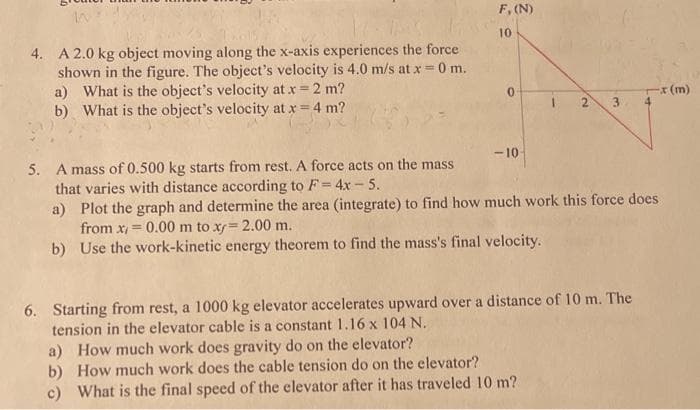A 2.0 kg object moving along the x-axis experiences the force shown in the figure. The object's velocity is 4.0 m/s at x = 0 m. a) What is the object's velocity at x = 2 m? b) What is the object's velocity at x = 4 m? (5) A mass of 0.500 kg starts from rest. A force acts on the mass that varies with distance according to F=4x-5. F, (N) 10 0 -10 3 -x (m)
A 2.0 kg object moving along the x-axis experiences the force shown in the figure. The object's velocity is 4.0 m/s at x = 0 m. a) What is the object's velocity at x = 2 m? b) What is the object's velocity at x = 4 m? (5) A mass of 0.500 kg starts from rest. A force acts on the mass that varies with distance according to F=4x-5. F, (N) 10 0 -10 3 -x (m)
College Physics
11th Edition
ISBN:9781305952300
Author:Raymond A. Serway, Chris Vuille
Publisher:Raymond A. Serway, Chris Vuille
Chapter6: Momentum, Impulse, And Collisions
Section: Chapter Questions
Problem 28P: Two objects of masses m1 = 0.56 kg m2 = 0.88 kg are placed on a horizontal frictionless surface and...
Related questions
Topic Video
Question

Transcribed Image Text:F, (N)
10
IN
4. A 2.0 kg object moving along the x-axis experiences the force
shown in the figure. The object's velocity is 4.0 m/s at x = 0 m.
a) What is the object's velocity at x = 2 m?
What is the object's velocity at x = 4 m?
0
-x (m)
b)
1 2 3
-10
5. A mass of 0.500 kg starts from rest. A force acts on the mass
that varies with distance according to F= 4x-5.
a)
Plot the graph and determine the area (integrate) to find how much work this force does
from x = 0.00 m to xy= 2.00 m.
b) Use the work-kinetic energy theorem to find the mass's final velocity.
6. Starting from rest, a 1000 kg elevator accelerates upward over a distance of 10 m. The
tension in the elevator cable is a constant 1.16 x 104 N.
a) How much work does gravity do on the elevator?
b) How much work does the cable tension do on the elevator?
c) What is the final speed of the elevator after it has traveled 10 m?
Expert Solution
This question has been solved!
Explore an expertly crafted, step-by-step solution for a thorough understanding of key concepts.
This is a popular solution!
Trending now
This is a popular solution!
Step by step
Solved in 2 steps with 2 images

Knowledge Booster
Learn more about
Need a deep-dive on the concept behind this application? Look no further. Learn more about this topic, physics and related others by exploring similar questions and additional content below.Recommended textbooks for you

College Physics
Physics
ISBN:
9781305952300
Author:
Raymond A. Serway, Chris Vuille
Publisher:
Cengage Learning

University Physics Volume 1
Physics
ISBN:
9781938168277
Author:
William Moebs, Samuel J. Ling, Jeff Sanny
Publisher:
OpenStax - Rice University

Glencoe Physics: Principles and Problems, Student…
Physics
ISBN:
9780078807213
Author:
Paul W. Zitzewitz
Publisher:
Glencoe/McGraw-Hill

College Physics
Physics
ISBN:
9781305952300
Author:
Raymond A. Serway, Chris Vuille
Publisher:
Cengage Learning

University Physics Volume 1
Physics
ISBN:
9781938168277
Author:
William Moebs, Samuel J. Ling, Jeff Sanny
Publisher:
OpenStax - Rice University

Glencoe Physics: Principles and Problems, Student…
Physics
ISBN:
9780078807213
Author:
Paul W. Zitzewitz
Publisher:
Glencoe/McGraw-Hill